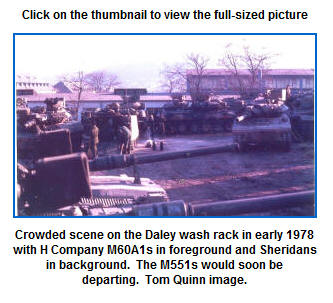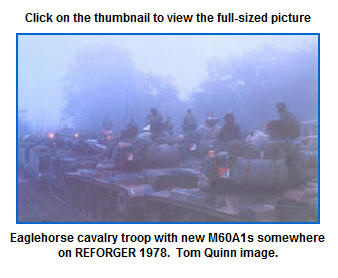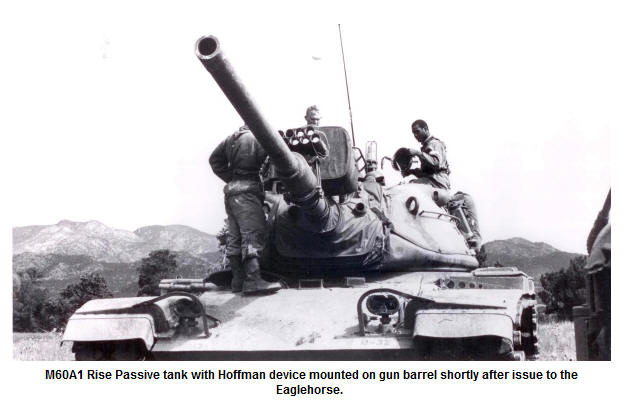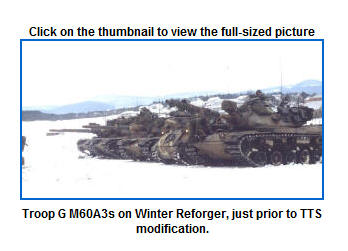|
Tanks a Lot!
Sadly, at some point, the file copies of Blackhorse Newspaper that
had been retained by Regiment were reduced to a small collection of
clippings. If you call or visit the 11th ACR Museum at Fort
Irwin and ask to see what they have, out comes a folder, out spills
a pitiful collection of yellowed partial pages and there goes what
should have been an invaluable collection of names, dates and
events. In a folder marked Force Modernization, a small
collection of articles related to the M60 tanks and virtually
nothing on M1 or similar new weapons systems. I am sure
at the time, reducing the file copies of the monthly paper to a
single folder must have seemed like a really good idea.
The newspaper images that accompanied these articles were in rough
shape, I have substituted images from the site photo collection that
are appropriate.
Tanks and the 1980s
What was Saved
Blackhorse
June 1978
June was the month they all waited for. There were those among
them that dreaded it, but it happened. Two squadrons of the
Regiment turned in the vehicles which were babies to some
and tin cans to others.
During the month of June the First and Second Squadrons exchanged
their Sheridans (M551A1 Armored Reconnaissance Airborne Assault
Vehicles ) for new M60A1 Main Battle Tanks.
Each squadron turned in 54 Sheridans and received 36 M60A1s which
will now be used by members of the line Troops. Several new
soldiers with the 19E MOS are and will be replacing the former 11DR8
MOS soldiers which are Armored Reconnaissance Specialists who are
Sheridan qualified. In addition, former Sheridan crewmembers
will receive on the job training as crewmembers of the new battle
tanks.
A soldier
from B Troop is pictured here involved in some of that
training as he crawls with a tow cable for time, one of the
events in the Tankers PT training. Other events
and requirements of the test are: The ammo lift, which
requires the soldiers to lift a dummy 105mm round above
their head at least 45 time, the low crawl in which the
soldier low crawls under four M60A1s I less than 24 seconds,
the track block shuffle, where you move a stack of ten track blocks 25
meters and re - stack them exactly as they were in 3
minutes, 17 seconds, rolling a road wheel for time and doing
a two mile for time. In the case of B Troop, the top
performer gets the rest of the afternoon off.
shuffle, where you move a stack of ten track blocks 25
meters and re - stack them exactly as they were in 3
minutes, 17 seconds, rolling a road wheel for time and doing
a two mile for time. In the case of B Troop, the top
performer gets the rest of the afternoon off.
This is only a small part of the intensive training that is going on
to familiarize the soldiers with the new tanks. Every day the
soldiers are being briefed and taught by tank qualified personnel on
all aspects of the vehicles. This is being accomplished by
maintenance ands weapons system classes on the subject. In
addition training is also being put to use I the local field
training sites to prepare soldiers for battle field conditions.
Pictured below are members of First Squadron, including commander
LTC James B. Taylor, waving farewell to one of the last Sheridans
rolling out the gate as a new M60A1 takes up its place on the line.
The Blackhorse
May 1980
Eaglehorse Moves to
Space Age
Sp/5 Ron Graddy
Beams of light wink through space striking the enemy war machines.
Suddenly the enemy war machines burst into flames as the good guys
score yet another hit.
Of this was the post theater you might think you were watching
another science fiction film like Star Wars. What is really
happening is that laser range finder equipped tanks of the 2nd
Squadron 11th Armored Cavalry Regiment from Bad Kissinger, are on
guard.
Eaglehorse squadron solders have become believers in space age
warfare with the addition of the M60 A3 tank to their already
impressive arsenal.
The M60A3 is an improved version of the Armys M60 series which has
been in the field for decades.
M60A3s feature a laser operated rangefinder that gives instant range
readouts with the flick of a finger. This computer operated
system has dramatically increased the chance of a first round hit in
modern tank combat. For Eaglehorse men the A3 could mean the
difference between life and death on some future battlefield.
According to Sgt. Kenneth Neff of Fox Troop, The M60 A3s take the
guesswork out of the system. A tanker for all of his career,
Neff is impressed with his new equipment.
For a tanker, speed is everything, Neff relates. If you
dont get an opposing tank with the first round, that tank may very
well get you.
Two weeks of transition training from the squadron old M60 A1s to
the A3 consisted of both classroom and hand on training.
You have to have full confidence in the computer, say instructor
SFC Donald Stockton. Experienced tankers find that the
hardest thing is letting the computer handle all the small
adjustments that they have normally handled. Once they believe
that the computer can do the job, they have no problems.
First round hit capability is important to modern tankers, says
Stockton, and experienced tanker with many years of service with the
M60 series. The m60A3 greatly increases the tankers chances
for successful combat. The M60A1 only gave about a 30 to 40
percent chance of obtaining that all important first round hit.
The A3 provides at least a 70 percent hit probability.
And remember this is an average, not what the best crews can do.
After taking
possession of their new tanks and completing classroom and
dry fire training, Eaglehorse tankers moved to the live fire
ranges. Here the battlefield zero was checked for
accuracy.
Using modern technology, tankers were given instant corrections from
the range tower. Unaware of the system, tank crews were amazed
at the quality of guidance from the tower.
With Television cameras and a video tape playback machine, the
transition team was able to see the exact spot where the round hit
the target. With the instant replay system instructors could
playback the firing and freeze the scene which showed the round
hitting the target.
After zeroing - in, tanks and crews moved on to another range to
fire at both moving and still tagers. Fox 11 scored an
impressive 87 percent on the range the first time out. PFC
Columbus Waters, the Fox 11 driver, relates, Ill get the rest of
the crew there to do their job. They just have to keep the
enemy off my back.
Fox 22 is another 2nd Squadron 11th ACR tank. Called
SATE for Supreme Allied Tank Europe , by its crew it also posted
respectable scores on the range. SSG Charles Cox, the tank
commander, said, The new system is a vast improvement over the old
way of doing things. As soon as we fully understand and are
fully trained in the system we will be almost unstoppable.
Sp4 Gary Wade is the Fox 22 gunner. Wade a and PFC Abraham
Dumas, the loader, both feel the new system makes them more combat
effective. Sp4 Steve Dohler, the Fox 22 driver, feels, We
are a team. As long as I do my job we move. When the
loader and the gunner dont do their job we become just an expensive
taxi. It takes all of us working together to make it happen.
For tank commander SFC Kenneth Shields, Neff and the rest of the Fox
14 crew the improvements on the tank are a big bonus.
Confident of his new weapon, Neff shows it off as proudly as someone
else might show off a new car. I press this button and the
laser fires and bingo we have the range. You have to be
careful with the laser though; you could blind someone if you hit
them. Turing serious Neff continues, But a tank is not
meant to be a safety item anyway. It is meant to kill
the enemy and with this new weapon, I think we can do a better job
at that. The Fox 14 tank was nicknamed the Bro - Ken - Toy by its
crew and for a logical reason they feel. Bro is for PFC
Jeffry Smith, the driver. Ken is the first names of
both Shields and Neff and Toy is the nickname for the
loader, PFC Richard Coker.
Shields says with a grin, Coker is a short guy. We started
calling him Toy Tanker because he is so short and the name stuck
Neff who recently reenlisted as a tanker says, I like what I do.
He believes If you like what you are doing you should stay in that
line of work.
In modern combat situation accuracy counts. This belief
accounts for the importance of the M60 A3 improvements over the
older M60A1. The Soviets, say Department of the Army
officials, have several medium tanks fielded. Their T
54, T 55 and T 62 and T 72 are considered at least marginally
superior primarily because of their advanced armor protection.
The introduction of the new main battle tank, the XM -1, is designed
to offset this advantage through, say Department of the Army
officials.
The Blackhorse
March 1981
Eaglehorse is first
to test new sights.
In January of this year the Eaglehorse Squadron was the first
squadron in the Regiment to receive the new tank thermal sight.
They fired at Wildflecken Training Area shortly after receiving the
sights, and reports from the squadron are that the new sight is
fantastic.
SFC Robert Davis, a platoon sergeant with Golf Troop, was on the new
equipment team from Fort Knox that brought the M60A3 to Europe
in February 1979. He has had quite a bit of experience with
the sights as he has been working with them since November 1978.
The tanks were originally fitted with searchlight and during the
retrofit these searchlight packages were removed and the tank
thermal sight was put in its s place by fitting the sight to the
turret, The whole procedure took about 8 hours per vehicle,
Davis said.
The team that conducted the retrofit was form the States and
assisted by a team from Mainz. They did an outstanding job of
fitting and giving instruction on the sights, said Davis. The
instruction included the standard operating procedures for the
sights as well as troubleshooting and maintenance.
Due to
other missions in the squadron it took about one month to
refit the entire squadron and give our soldiers practical
instruction, Davis said.
The reaction from the solders of the Eaglehorse after firing at
Wildflecken was fantastic. Our guys were highly motivated to
train after using the sights because it is a lot simpler to use and
easier and quicker to shoot, said Davis. Davis is very
confident in the new sights saying, I think its the best the Army
has now or in the past.
Although Davis found no disadvantages or frustration with the new
sights, the squadron master gunner, SFC Roger Franklin said that the
one frustration was setting up the ranges. The sights were
no problem as far as the tanks are concerned; the problem was
setting up the range at Wildflecken, but when we go to Graf this
summer I dont think well have the same problem. said
Franklin.
The general consensus, however, among the Eaglehorse soldiers is
that the new thermal sights are great. Said Franklin,
The morale has never been better, the soldiers are really excited
about the new sight and as far as a combat situation, we are ready
now!
August 2014 |